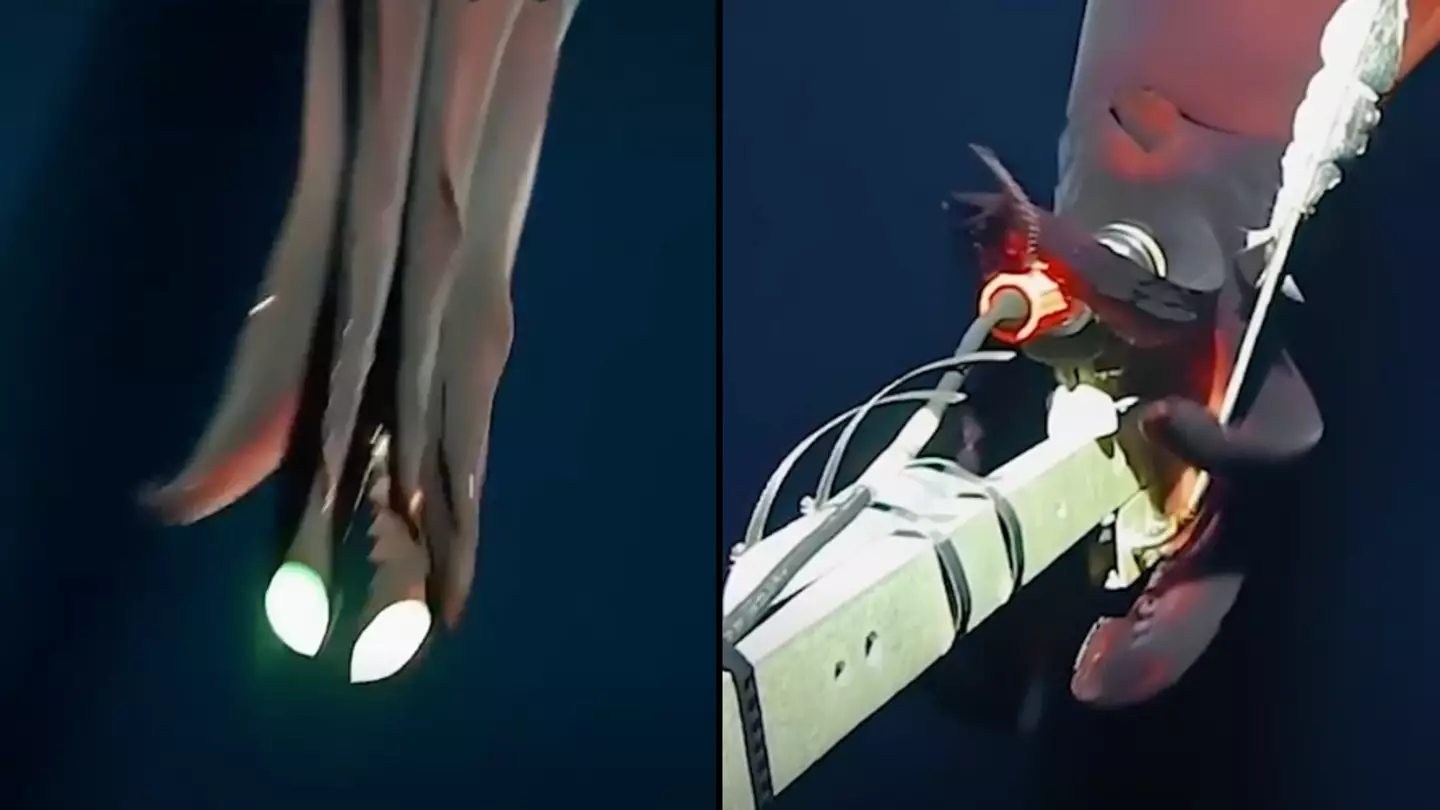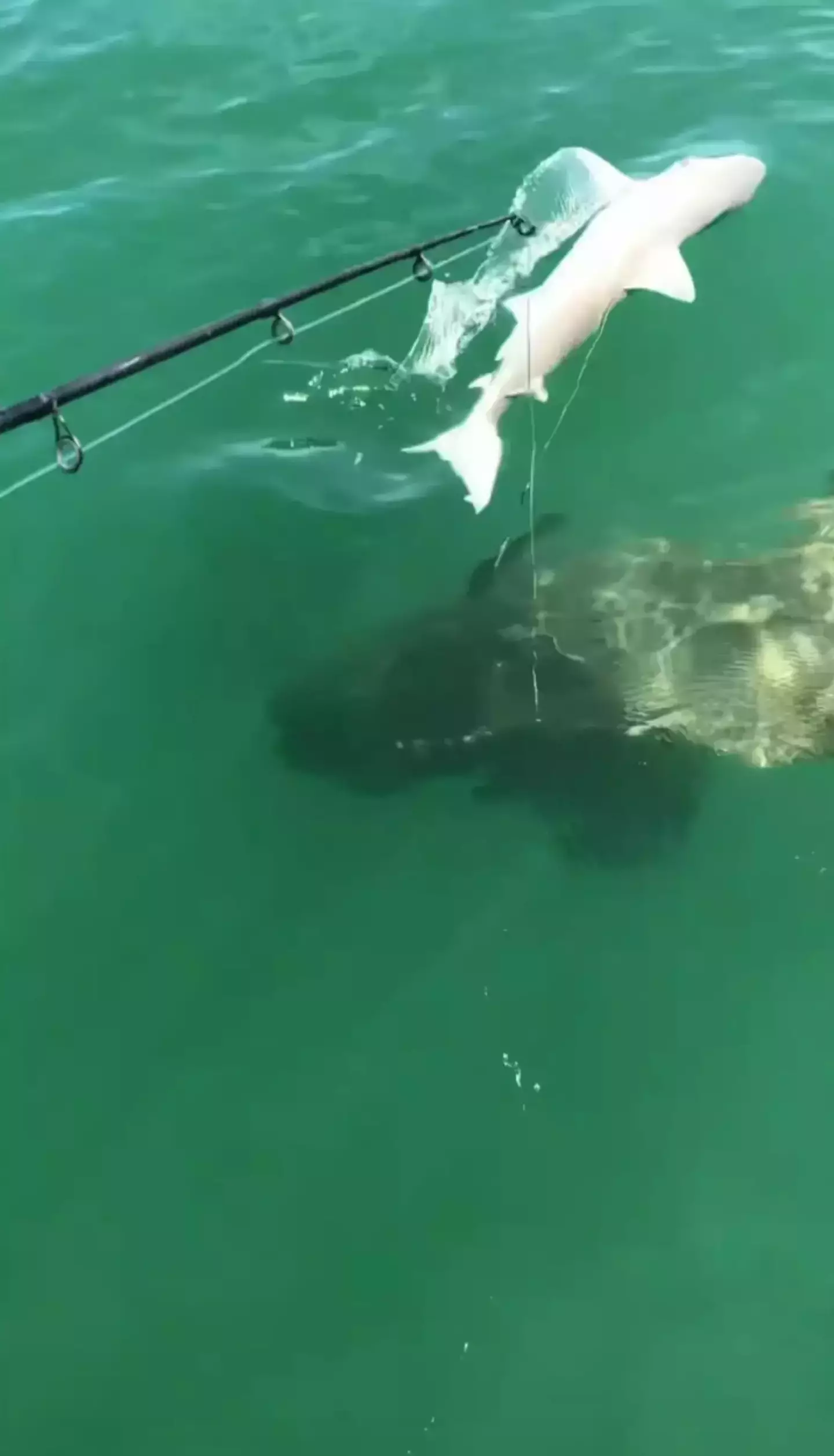
Humans can only dive down to depths of about 300 metres, and to get further we need special equipment like submersibles to pop down in.
Technology can get where the human body can’t, so when scientists conducting an expedition into the Tonga Trench in the Pacific Ocean dropped a camera down there, they got a good look at what lies beneath.
Beyond a certain depth lies a world that is relatively untouched by the world above so anything that drops into it warrants some investigation by the denizens of the deep.
This is pretty normal shark behaviour since they don’t have hands and have to investigate things by using their mouth, not that you’d want to have a shark be curious about you because then it might bite you.
Dr Jessica Kolbusz explained over the video that this footage had been taken at a depth of 1,400 metres and somewhere to the west of the Tonga Trench.
She said that the Pacific Sleeper Shark could measure up to 4.4 metres long, though the largest of them could have a length of over seven metres which is pretty freaking massive.
As for this magnificent but slightly terrifying creature of the deep blue sea, the expert explained that this particular shark was a lady.

Look at her, she’s magnificent. (The Tonga Trench Expedition)
She said: “This observation occurred to the west of the Tonga Trench, we assumed that it was fairly big, around 3.5 metres long, it was at 1,400 metres depth and due to the lack of observable claspers on the pelvic fins we’ve identified it as female.”
“She goes straight for the camera, from this view we can see completely inside the shark’s mouth.
“Not too long after that she realises it doesn’t taste very good and goes for the bait. It was around 2.5 degrees Celsius which makes sense as we know that they prefer cooler waters.”
Indeed, as Dr Kolbusz narrated, we did get to see just what an inside view of the Pacific Sleeper Shark’s mouth looked like.

The big shark had a bit of a nibble of the camera, giving a good look at what being eaten by it would be like, before moving onto the bait. (The Tonga Trench Expedition)
Fortunately for the scientists and the shark, it soon moved on to the fish they had next to the camera as bait, and did not destroy the rather unappetising deep-sea camera in an attempt to eat it.
After chomping down on the bait attached to the camera rig the very large shark then swam away, giving the scientists a good shot of just how big she was.
Built for those cold, dark depths to which a human dare not dive, the Pacific Sleeper Shark is a very impressive creature which can hunt quietly as it makes little noise moving about in water.
They tend to exist on a diet of bottom dwelling fish, while shark stomachs that have been studied also indicate they have a taste for the Giant Pacific Octopus.

It’s things like this that make people scared of the sea, and it’s worth noting that we as humans have only explored five percent of the world ocean, according to NOAA Ocean Exploration.
To think about how many creepy and scary creatures live in the depths of the sea, and the fact that there’s a high possibility that there are even more that we don’t know about – which scientists might not ever discover.
The latest bit of breath-taking footage has been released by scientists from the University of Western Australia and Kelpie Geosciences in the UK, that has left viewers stunned.
In a clip that rivals a sub’s interaction with an ancient deep-sea creature up close, where scientists could see its eye, this ranks highly among creepy-yet-educational ocean exploration videos.
It is said that creature mistook the camera for prey in the South Pacific on Wednesday 8 May, with Associate Professor Stewart stating: “As we were reviewing the footage, we realised we had captured something very rare.”

So much of the sea has been left unexplored. (Getty Stock Photo)
In the video, a rare squid can be seen wrapping its arms around a camera 1026m below the surface, where it is almost pitch black.
It’s not just any rare squid though, known as the Taningia Danae, it can be seen making its approach towards the camera and spreading its tentacles over the camera lens, seemingly thinking that it was something that it could eat.
The species is known for having two incredibly large photophores on the end of two of its tentacles that produce bioluminescence, which have also been described as ‘headlights’.
They are the largest known photophores in the known world, and are also known to produce flashes in the dark ocean to disorientate prey while hunting, which can also be seen in the video.

Two angles of the footage highlighted just how massive the squid was. (UWA/Inkfish)
The equipment captured two angles of the squid wrapping its tentacles around the lens, one from the scene and one from behind, showcasing just how massive the squid is.
Also known as the Dana octopus squid, it is one of the largest known squid species, able to reach a total length of 2.3m. The largest known specimen weighed a whopping 161.4kg.
The scientists in the OceanX sub itself were left in awe by what they saw, as they made history.
The video was posted on OceanX YouTube channel four years ago and is just over 90 seconds long, but what the explorers managed to capture is truly breath-taking.
In the description of the video, the company states that it has partnered with the Cape Eleuthera Institute to become the first ever submersible to tag an animal.
“Our objective was the deep-sea shark, the bluntnose sixgill,” it explained.
“This ancient species predates most dinosaurs, and is a dominant predator of the deep sea ecosystem.”
FSU Marine Lab’s Dr. Dean Grubbs was the lead scientist on the mission, and succeeded in achieving the goal.

The pre-historic shark helped the team tag an animal from a submersible for the first time ever. (Youtube/OceanX)
Grubbs let the team to become the first ever to put a satellite tag on the elusive species of sharks on the sea floor, with scientists in the past only able to do so by bringing them up to the surface.
The team did this on the sea floor, and the footage also shows how shocked the men were in the sub.
Spotting the shark swimming around it, one of them said: “Oh, wow!”
“Look at the width of that thing!”
Attempting to get her in the prime position to tag, they were hesitant to tag her when she was belly-side, waiting for her to get closer.
Which she did, pushing her nose up against the side of the submarine, glancing up at the intrigued scientists, even seeming to roll her eyes as she swam away.
The scientists couldn’t believe just how big the female shark was, pointing out that she was larger than average.

The shark’s pupils were deep green as it glanced up at the scientists. (Youtube/OceanX)
Her species usually grow up to 20-feet in length, but rarely anyone has been so up close and personal with one before.
The species predates most dinosaurs, meaning they have roamed the seas for tens of millions of years.
People were just as in awe in the comments section.
One user said: “If not the size, this shark’s eye alone would have given me a straight heart attack.”
Because this enormous sea creature managed to make mince meat out of the predator with just one bite – and a gang of flabbergasted fishermen managed to catch the whole thing on camera.
Which is a good job really, as this is one of those things that’s got to be seen to be believed.
Even though seeing a shark get devoured wasn’t on their list of plans for that day, they just couldn’t look away.
The lads were out on the water off the coast of Goodland, Florida, while having some fun with their fishing rods when they managed to hook a blacknose shark.
But as they soon found out, you can never be too sure what’s lurking in the water – as the 3ft beast was actually accompanied by three more formidable opponents.
The fishermen spotted three Atlantic goliath groupers gearing up to take the shark down and John quickly grabbed his phone to record some footage.
He can be heard exclaiming: “There’s three of them! There’s three of them. I swear, there’s three of them. Look at those guys waiting for him.”

Captain John Brossard captured incredible footage of the terrifying moment (Pen News)
The groupers – which are saltwater fish known for their staggering size – can be seen circling their prey as the blokes debate which one is the biggest, before the top dog decided to reveal itself.
In one fell swoop, one of the giant fish leapt out of the water, secured the shark between its jaws and swam off with it.
And seen as though they had the beast hooked on their fishing line, the fishermen were heard urging one another to ‘hold on tight’ as their boat swayed when the line snapped.
Speaking of the extraordinary incident, John said him and his crew were left stunned by the strength of the groupers.
He explained: “Basically we were shark fishing when all of a sudden two or three goliath groupers started hanging out under the boat waiting for our catch to come in.
“We were just thinking, ‘Wow, unbelievable! Something is going to eat a shark and it’s bigger than a shark’.
“We were very surprised. Basically it ate the shark, and took down and broke the line. We were using a 50-pound test line and that was not enough.”

One of the Atlantic goliath groupers took down the shark in one swift movement (Getty Stock Image)
Hazarding a guess at how much one of the huge fish weighed, he reckoned that they could have tipped the scales at 500lbs.
Although he still doesn’t want a run-in with a shark, John says the encounter left him feeling that the creatures clearly aren’t as fearsome as they’re made out to be.
He continued: “Do they deserve all the hype? I think sometimes yes and sometimes no, but most of the time, no.
“Of course, if you get in their way, in their territory and the water is dirty, yes, they will taste you to see if you are good eating.”
John also explained that out in the Florida Everglades, there are plenty of animals to be wary of, adding: “There are sharks, alligators, crocodiles, pythons, dolphins and manatees all in one place.
“It’s the only place in the world that has all these creatures in one place and everything there tries to eat everything else.
“Bull sharks have been seen getting eaten by crocodiles and alligators sometimes, and sharks also get eaten by bigger fish there.”
And bizarrely, this is exactly the reason why he chose to fish in that spot – even though he’s well aware of the risks.
“What we like to catch is big fish,” John said. “They are all predators in the Everglades. You don’t wanna get lost there and have to walk or swim home.”



